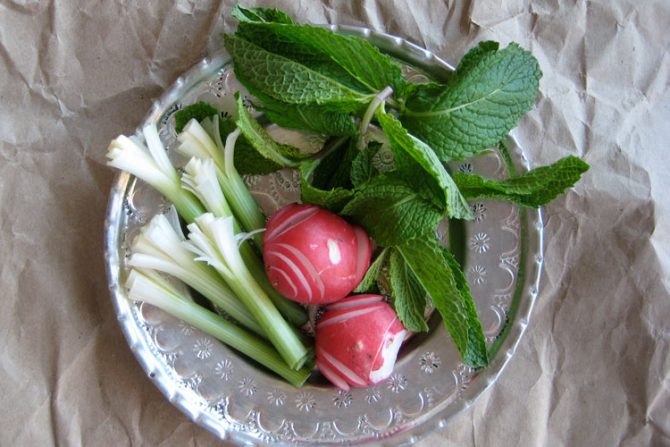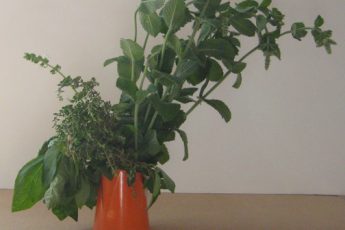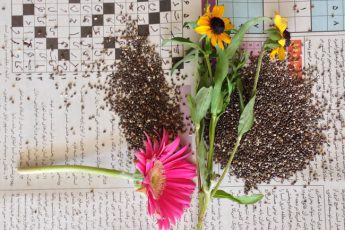If you come from a Persian household or have had occasion to dine at one, you are privy to the fact that a Persian table at mealtime is considered naked without sabzi khordan (Persian: سبزی خوردن ).
Sabzi khordan literally translates to either “edible herbs” or “eating herbs” and refers to an assorted plate of fresh herbs and raw vegetables. An assortment that might include: basil (reyhan), green onions aka scallions (piyaz che), parsley (jaffari), chives (tareh), coriander (geshniz), cilantro, mint (na’nah), fenugreek (shanbalileh), radishes (torobche), savory (marzeh, origany or sweet fennel), tarragon (tarkhun), Persian watercress (shâhi) and maybe even sliced raw onions. (To see the vast potential variety of sabzi khordan, you might want to feast your eyes on this Google image search for سبزی خوردن.)
The choice of which fresh herbs and how much of them to use to assort the Persian herbs platter are entirely up to one’s whim and whimsy and provisions-at-hand; although typically, sabzi khordan is not really sabzi khordan without the presence of radishes which are crunchy, healthy, add a pop of color, and pack a nice bit of heat.



To make a meal out of sabzi khordan, it’s customary to add walnuts and feta cheese to the fresh herbs platter and make a logmeh (roll up sandwich) of it with some type of flat bread – ideally a delicious Persian bread like sangak or lavash or barbari. This combo of bread and cheese and walnuts with sabzi khordan‘s fresh herbs is known as noon va panir va sabzi (نون و پنیر و سبزی). A humble but nutritious and tasty repast that hits the spot, without any ado, on the spot.
As noted, sabzi khordan is pretty much served par for course with every Persian meal — as constant a table setting as the salt and pepper. or a pitcher of water. But why exactly is sabzi khordan such a popular habit and ingrained fixture of Persian cuisine? How did it assume such an integral role? Well, for one thing, sabzi khordan serves a multitude of purposes as: garnish, side dish, appetizer, and basically a condiment to compliment and enhance the pleasure of a meal.
Also, when leafing through a favorite & wonderful encyclopedic cookbook (by Ostad Najaf Daryabandari – which alas is only available in its original Farsi language, hopefully to be translated by an intrepid person soon) I learned that in the olden-days of Iran, it was customary to finish an elaborate feast with a few mouthfuls of bread and cheese and sabzi khodran. This custom was called dahaneh talayee or “golden mouth.” (Isn’t that a cool imagery?) Which I interpret as a gesture meant to cleanse and refresh the palette.This may explain the enduring popularity of sabzi khordan as a mealtime fixture – not just to enhance the flavor and pleasure of food, but also as a healthy and tasty palette cleanser.
The genesis of sabzi khordan might also trace its roots to the sardi garmi (the balancing of hot and cold) classification philosophy of Persian cuisine. This ancient Persian food philosophy is a rich and complex topic that I won’t deign or dare to address in this post.
What I will dare to address here, however, are a few pointers to make a very simple sabzi khordan plate of radishes, green onions and basil to call your own.


[recipe title=”Simple Plate of Sabzi Khordan” difficulty=”Easy Peasy!”]
INGREDIENTS
A bunch of: radishes, fresh basil (and/or mint) and green onions aka scallons
To Prep Radishes
Scrub wash and dry a few radishes. Chop tops and bottom roots off. With a sharp knife make a few cutting indents — a little over 3/4 way down, but not all the way, slightly rotate and repeat a few times — to make a radish florette garnish. (If you want to get really fancy about it, here are some images to inspire you.)
To Prep Green Onions
Rinse green onions under cold tap water. Peel off the slimy skin on the white parts. Line a tray with a paper towel and lay the green onions to dry completely.
Bunching up several green onions at a time, place on a cutting board, and with a sharp knife, trim the stringy root ends by slicing about 1/4 inch above the roots. Chop off almost all of the green tops, leaving only a 1/4 inch or so of it intact. (You can use the green tops for something else, like a soup or omelet, after discarding any wilted or damaged tops amongst the bunch.)
To Prep Fresh Basil
Fresh basil bruises easily, so handle with care. Instead of using a knife, use your hands to trim the stems. Gently wash and rinse in cold water. Dry completely on a tray lined with paper towel.
Same story if you either sub or add mint to the platter. Wash, leave to dry, trim the stems.
Serve
Artfully arrange assorted handfuls of radishes, green onions and fresh basil (and other fresh herbs) on a small plate. Serve alongside a main dish; or, make a sandwich of it by adding feta cheese, walnuts and bread.
(Needless to say: this simple arrangement can be expanded upon per your desire to include many other types of fresh herbs.)
[/recipe]

Make it. Enjoy it. And noosh’e joon!




Inspiring, beautiful, delicious, healthful… what more to ask for?
thank you thank you thank you! 🙂
That’s so interesting! I love learning about other cultures and especially food related customs. Thanks for sharing!
I feel the same, dear Mary Frances, it’s so fun learning about the food of other cultures. One of the gifts of the Internet and food blogging!
We have something similar in Italy too. Raw vegetables served with a olive oil dip … such a lovely appetizer!
Francesca, what’s it called? Inquiring minds want to know.
It’s called Pinzimonio
everything sounds delightful in Italian!
you do indeed and it is wonderful: https://polianthus.wordpress.com/2015/01/30/get-your-veg-on-with-this-voluptuous-italian-raw-vegetable-starter/
had it in italy and have been an addict ever since
So interesting, thank you so much for the lesson 🙂
my pleasure! sorry for belated! 🙂
I love having a big platter of fresh raw vegetables and herbs on the table. This is just beautiful.
there’s much talk of the Italian version of this! 😉
Sabzi Khordan’s two most popular ingredients are parsley and mint! Other herbs include, tarragon, leek chives. Here is a more complete look: http://turmericsaffron.blogspot.com/2010/04/sabzi-khordan-persian-assortment-of.html
Dear Dera, there are no hard and fast rules and as mentioned in the post, the choice of assorted herbs/veggies is “up to one’s whim and whimsy and provisions-at-hand”, for example, parsley has never been a favorite in our household when it comes to sabzi khordan, while it may have played an integral role in the traditional sabzi khordan of another family. Thank you for visiting and commenting and for the link to one of my favorite Persian food bloggers. I’ll make a note to peruse it at leisure.
I love this tradition and adopted it as my own – however, on your plate there is a herb missing compared to the herbs served by friends in Orange county , I think it’s a type of basil? it’s one that was always served in southern California, I found it again in Dubai, brought it home, in Grenada and brought it home, but the plants invariably die. Do you know which herb I mean? My friends would have brought seeds from Iran but wasnt legal so I have had to go without and i still dont know the name..
Dear Polianthus, You’ve got me stumped. I don’t think you mean watercress as you’d be familiar with that. I’m thinking maybe you mean “tareh shahi?” Do you see it pictured here in this link: http://bit.ly/1GwESpX ?
I like the idea of “golden mouth” !
It’s a cool term, no? 😉
this sounds so fresh and lovely, especially for summer. lately I’ve been all about herb salads, and radishes and mint in almost everything.
Dear Chelsea, really can’t go wrong with that combination. a winning combo if there ever was one! Noosh ‘e jaan with all of your lovely and healthy herb salads!
there are many different types of basil. i have found that the “lemon basil”, which i can sometimes find in southern california in ethnic stores, seems the closest to the basil found in iran. there is a slightly different taste. we also eat the greens on the radishes i always joke with my family and friends about how they enjoy eating “alaf.” 😉
Maryam jaan,
Salam! Haha, love that, “alaf khordan” 🙂 May have to borrow that coinage from you!
Thank you re the info and tip about the lemon basil. I’ll be on the lookout for it next time I’m in southern California.
Mersi va mamnoon barayeh khondan va comment dadan! :))
[…] rice encircled by a valiant army of potato tadig, and then more lemons and olive, some sabzi khordan, a dish heaped with what looks like a plate of cut honey dew, a box of Kleenex, some bread, and a […]
[…] The Persian herb and feta platter and sabzi khordan have a long history in Persian food culture. My friend Azita/Fig and Quince, gives you even more details about our love affair with fresh herbs here. […]